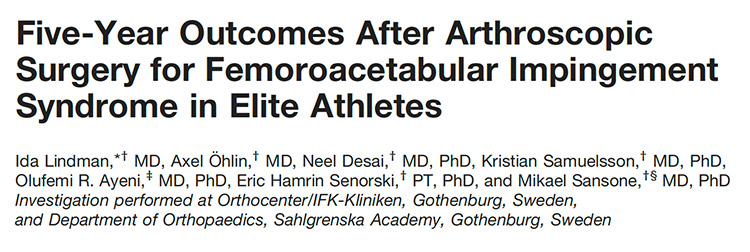Five-Year Outcomes After Arthroscopic Surgery for Femoroacetabular Impingement Syndrome in Elite Athletes.

Date: 16th April 2020
Title: Five-Year Outcomes After Arthroscopic Surgery for Femoroacetabular Impingement Syndrome in Elite Athletes.
Authors: Ida Lindman, Axel Ohlin, Neel Desai, Kristian Samuelsson, Olufemi R. Ayeni, Eric Hamrin Senorski, Mikael Sansone
Journal: The American Journal of Sports Medicine
Investigation performed at Orthocenter/IFK-Kliniken, Gothenburg, Sweden, and Department of Orthopaedics, Sahlgrenska Academy, Gothenburg, Sweden
Critical Appraisal:
This Journal Club meeting critically appraised the above paper which focuses on 5-year outcomes following arthroscopic surgery for femoroacetabular impingement in elite athletes.
Longer-term outcome studies such as this are becoming more valued within the hip arthroscopy literature and as such we read with great interest and anticipation the findings from this study. We were, however, left somewhat underwhelmed with the extent and presentation of the results raising more questions than it did providing answers.
The general consensus was that there was a superficial presentation of the results of this paper, where more comprehensive information could have been provided and expanded on.
Firstly this is a very heterogenous study cohort. Although the majority of cases were competitively involved in soccer, any conclusion from this study would be difficult to confidently relay to any specific athletic type.
While the authors do mention in the Methods section that radiological findings formed the basis of diagnosis of FAIS in this study, there was no radiographic indices provided in this paper. Furthermore while the authors do mention that this current paper follows on from a previously published 1-year outcome paper of the same cohort, the radiographic indices are also not present in this original study either. Considering pre-operative imagery was reportedly undertaken to form a diagnosis, precise measurements of the important angles (alpha angle, centre-edge angle etc) would have provided additional weight to this paper, which is one of the major shortfalls. The lack of this information is apparent in the Results section where there is no idea provided to the reader of the extent of bony resection performed and furthermore whether there is any predictor impact of degree of bony abnormality on patient-reported outcomes at 5 years post-op. The only description the authors provide in the Results is through saying “Since determining the precise extent of any impingement deformity is complicated to determine, all femoral abnormalities were carefully resected”.
There was also an exceptionally low rate of labral repair (9%)
18% of the cohort were lost to follow-up. The authors provide no descriptive analysis of these ‘lost to follow-up’ cases and whether any significant differences existed between them and those included in the results.
The authors of this study have used pre-defined minimal important change (MIC) values to determine clinically significant improvement. Considering the heterogeneity of the athletic subjects included it may have been more appropriate that this MCID value was calculated specifically for this study. As much as the PROMs need to be specific to the cohort being examined, so too should any calculated MIC value.
One of the reasons the authors provide for choosing the PROMs included in this study was that they were ‘validated for an active population’ however a large proportion of cases (77.4%) have decreased their pre-operative activity level and only 54% were still participating in competitive sports at 5 years. This raises question of the validity of the PROMs used for evaluating longer term progress following hip arthroscopy and consequently the specificity of the outcome scores reported.
Main Points/Summary
There are a number of known radiographic, demographic and surgical technique predictors which could influence post-operative outcomes, however none of these independent variables were evaluated in this study.
One of the main limitations was not allowing the reader to make their own assessment of what level of FAI this study group had, by not providing any radiographic indices.
Critical Review Panel:
The Hip and Groin Clinic, UPMC Whitfield, Ireland:
Mr. Patrick Carton MD FRCS (Tr&Orth) FFSEM, Consultant Hip Surgeon
Mr. David Filan MSc, Research Assistant
Ms. Karen Mullins PhD, Research Assistant







